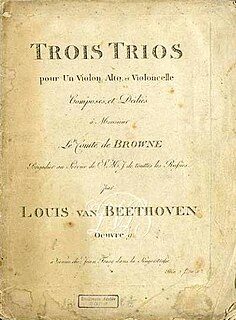Related Research Articles

Ludwig van Beethoven's String Quartet No. 12 in E♭ major, Op. 127, was completed in 1825. It is the first of Beethoven's late quartets.

Woldemar Bargiel was a German composer.
Hyacinthe Jadin was a French composer who came from a musical family. His uncle Georges Jadin was a composer in Versailles and Paris, along with his father Jean Jadin, who had played bassoon for the French Royal Orchestra. He was one of five musical brothers, the best known of whom was Louis-Emmanuel Jadin.
The six String Quartets, Op. 76, by Joseph Haydn were composed in 1797 or 1798 and dedicated to the Hungarian count Joseph Georg von Erdődy (1754–1824). They form the last complete set of string quartets that Haydn composed. At the time of the commission, Haydn was employed at the court of Prince Nicolaus Esterházy II and was composing the oratorio The Creation as well as Princess Maria Hermenegild Esterházy's annual mass.
Franz Ries was a Romantic German violinist and composer, son of Hubert Ries. He studied at the Paris Conservatory. He also worked in the publishing business.
The Complete Works of the Great Flutist is a collection of reissued and remastered recordings of performances by French flutist Marcel Moyse. The notes in the Muramastu Japanese site that markets the five CD box set only has English titles for the tracks, and has a number of mistakes regarding the playing order.
An organ concerto is a piece of music, an instrumental concerto for a pipe organ soloist with an orchestra. The form first evolved in the 18th century, when composers including Antonio Vivaldi, George Frideric Handel and Johann Sebastian Bach wrote organ concertos with small orchestras, and with solo parts which rarely call for the organ pedal board. During the Classical period the organ concerto became popular in many places, especially in Bavaria, Austria and Bohemia, reaching a position of being almost an integral part of the church music tradition of jubilus character. From the Romantic era fewer works are known. Finally, there are some 20th- and 21st-century examples, of which the concerto by Francis Poulenc has entered the basic repertoire, and is quite frequently played.

Joseph Haydn's Symphony No. 14 in A major, Hoboken I/14, may have been written between 1761 and 1763.

Marie-Alexis de Castillon de Saint-Victor was a French composer.

The three String Trios, Op. 9 were composed by Ludwig van Beethoven in 1797–98. He published them in Vienna in 1799, with a dedication to his patron Count Johann Georg von Browne (1767–1827). They were first performed by the violinist Ignaz Schuppanzigh with two colleagues from his string quartet. According to the violinist and conductor Angus Watson, these were probably Franz Weiss on viola and either Nikolaus Kraft or his father Anton on cello. Each of the trios consists of four movements:
Sonatas, duos and fantasies by Franz Schubert include all works for solo piano by Franz Schubert, except separate dances. They also include a number of works for two players: piano four hands, or piano and a string instrument.

The String Quartets, Op. 50, were composed by Joseph Haydn in 1787. The set of six quartets was dedicated to King Frederick William II of Prussia. For this reason the set is commonly known as the Prussian Quartets. Haydn sold the set to the Viennese firm Artaria and, without Artaria's knowledge, to the English publisher William Forster. Forster published it as Haydn's Opus 44. Haydn's autograph manuscripts for Nos. 3 to 6 of the set were discovered in Melbourne, Australia, in 1982.

Hooked on Classics 2: Can't Stop the Classics is an album by Louis Clark and the Royal Philharmonic Orchestra, published in 1982 by K-tel, part of the Hooked on Classics series.
Joseph Touchemoulin was a French violinist and composer of the classical period who mainly worked in Bonn and Regensburg.
From March 1816 to August 1817, Franz Schubert composed four violin sonatas. All four were published after the composer's death: the first three, D 384, 385 and 408, as Sonatinas in 1836, and the last one, D 574, as Duo in 1851. Schubert composed two more pieces for violin and piano, in October 1826 and December 1827 respectively: a Rondo, D 895, which was published during the composer's lifetime (Op. 70), and a Fantasy, D 934, which was premiered in January 1828, less than a year before the composer's death.
References
- ↑ Grande, Oliver, Miguel Simarro, Ángel (2004). Carlos de Ordóñez: Sinfonías, Concierto Para Violín En Re Mayor. Madrid: Instituto Complutense De Ciencias Musicales. pp. 367–417. ISBN 84-8048-562-0.
- ↑ A. Peter Brown, "Ordonez [Ordoñez, Ordonitz, Ordonetz], Carlo d' [Karl von]" in The New Grove Dictionary of Music and Musicians, ed. Stanley Sadie. New York: Macmillan Publishers Limited (1980): 13 702
- A. Peter Brown, Introduction to Carlo d'Ordonez, The Symphony Series B Volume IV: Carlo d'Ordonez: Seven Symphonies, ed. A. Peter Brown & Peter M. Alexander. New York: Garland Publishing (1979)